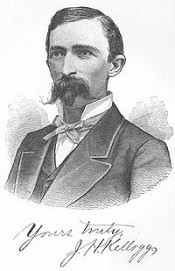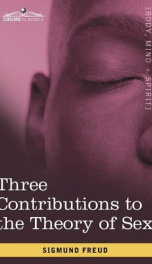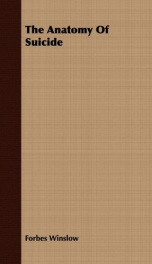Kellogg John Harvey

John Harvey Kellogg (February 26, 1852 – December 14, 1943) was an American medical doctor in Battle Creek, Michigan, who ran a sanitarium using holistic methods, with a particular focus on nutrition, enemas and exercise. Kellogg was an advocate of vegetarianism and is best known for the invention of the corn flakes breakfast cereal with his brother, Will Keith Kellogg.[1] Kellogg was born in Tyrone, Michigan,[2] to John Preston Kellogg (1806–1881) and Ann Janette Stanley (1824–1893). Kellogg lived with two sisters during childhood. By 1860, the family had moved to Battle Creek, Michigan, where his father established a broom factory. John later worked as a printer's devil in a Battle Creek publishing house. Kellogg attended the Battle Creek public schools, then attended the Michigan State Normal School (since 1959, Eastern Michigan University), and finally, New York University Medical College at Bellevue Hospital. He graduated in 1875 with a medical degree. He married Ella Ervilla Eaton (1853–1920) of Alfred Center, New York, on February 22, 1879. They did not have any children of their own, but raised over 40 children, legally adopting seven of them, before Ella died in 1920. The adopted children include Agnes Grace Kellogg, Elizabeth Kellogg, John William Kellogg, Ivaline Maud Kellogg, Paul Alfred Kellogg, Robert Moffatt Kellogg, Newell Carey Kellogg, and Harriett Eleanor Kellogg. Kellogg died in 1943 and was buried in Oak Hill Cemetery, in Battle Creek, Michigan, near James White and Ellen White, his parents, who are buried right next to the White family, C.W. Post, W.K. Kellogg, his brother and his brother's wife, Uriah Smith, and Sojourner Truth. Kellogg was a Seventh-day Adventist until mid-life and gained fame while being the chief medical officer of the Battle Creek Sanitarium, which was owned and operated by the Seventh-day Adventist Church. The San was run based on the church's health principles. Adventists believe in a vegetarian diet, abstinence from alcohol and tobacco and a regimen of exercise, which Kellogg followed, among other things. He is remembered as an advocate of vegetarianism[3] and wrote in favor of it, including after leaving the Adventist Church.[4] His dietary advice in the late 19th century, which was in part concerned with reducing sexual stimulation, discouraged meat-eating, but not emphatically so.[5] Kellogg was an especially strong proponent of nuts, which he believed would save mankind in the face of decreasing food supply. Though mainly renowned nowadays for his development of corn flakes, Kellogg also patented a process for making peanut butter and invented healthful, "granose biscuits." At the Battle Creek Sanitarium, Kellogg held classes on food preparation for homemakers. Sanitarium visitors engaged in breathing exercises and mealtime marches to promote proper digestion of food throughout the day. Because Kellogg was a staunch supporter of phototherapy, the sanitarium also made use of artificial sunbaths. Kellogg made sure that the bowel of each and every patient was plied with water, from above and below. His favorite device was an enema machine that could rapidly instill several gallons of water in a series of enemas. Every water enema was followed by a pint of yogurt — half was eaten, the other half was administered by enema, “thus planting the protective germs where they are most needed and may render most effective service." The yogurt served to replace the intestinal flora of the bowel, creating what Kellogg claimed was a squeaky-clean intestine.[6] Kellogg believed that most disease is alleviated by a change in intestinal flora; that bacteria in the intestines can either help or hinder the body; that pathogenic bacteria produce toxins during the digestion of protein that poison the blood; that a poor diet favors harmful bacteria that can then infect other tissues in the body; that the intestinal flora is changed by diet and is generally changed for the better by a well-balanced vegetarian diet favoring low-protein, laxative, and high-fiber foods; and that this natural change in flora could be sped by enemas seeded with favorable bacteria, or by various regimens of specific foods designed to heal specific ailments. Kellogg was a skilled surgeon, who often donated his services to indigent patients at his clinic.[7] Although generally against unnecessary surgery to treat diseases,[8][9][dead link] he did advocate circumcision, allegedly to prevent masturbation. He had many notable patients, such as former president William Howard Taft, composer and pianist Percy Grainger, arctic explorers Vilhjalmur Stefansson and Roald Amundsen, world travellers Richard Halliburton and Lowell Thomas, aviator Amelia Earhart, economist Irving Fisher, Nobel prize winning playwright George Bernard Shaw, actor and athlete Johnny Weissmuller, founder of the Ford Motor Company Henry Ford, inventor Thomas Edison, and famous actress Sarah Bernhardt.[10] [11] John Kellogg and his brother Will Keith Kellogg started the Sanitas Food Company to produce their whole grain cereals around 1897, a time when the standard breakfast for the wealthy was eggs and meat, while the poor ate porridge, farina, gruel, and other boiled grains. John and Will later argued over the recipe for the cereals (Will wanted to add sugar to the flakes). So in 1906, Will started his own company, the Battle Creek Toasted Corn Flake Company, which eventually became the Kellogg Company, triggering a decades-long feud. John then formed the Battle Creek Food Company to develop and market soy products. The Kelloggs did not invent the concept of the dry breakfast cereal. That honor belongs to Dr. James Caleb Jackson, who created the first dry breakfast cereal in 1863, which he called, "Granula." A patient of John's, Charles William Post, would eventually start his own dry cereal company, Post Cereals, selling a rival brand of corn flakes. Dr. Kellogg later would claim that Charles Post stole the formula for corn flakes from his safe in the Sanitarium office. As an advocate of sexual abstinence, Kellogg devoted large amounts of his educational and medical work to discouraging sexual activity, on the basis of dangers both scientifically based at the time - as in sexually transmissible diseases - and those taught by the Seventh-day Adventist Church through the writings of Ellen White.[12][13][14][15] He set out his views on such matters in one of his larger books, published in various editions around the turn of the 20th century under the title Plain Facts about Sexual Life and later Plain Facts for Old and Young.[5] Some of his work on diet was influenced by his belief that a plain and healthy diet, with only two meals a day, among other things, would reduce sexual feelings. Those experiencing temptation were to avoid stimulating food and drinks, and eat very little meat, if any. Kellogg also advocated hydrotherapy and stressed the importance of keeping the colon clean through yogurt enemas.[16][17] He warned that many types of sexual activity, including many "excesses" that couples could be guilty of within marriage, were against nature, and therefore, extremely unhealthy. He drew on the warnings of William Acton and expressed support for the work of Anthony Comstock. He appears to have followed his own advice, since, although he and his wife were married for over 40 years, they likely never had sexual intercourse and maintained separate bedrooms throughout. It has been suggested he worked on Plain Facts on their honeymoon.[18] He was an especially zealous campaigner against masturbation; this was an orthodox view during his lifetime, especially the earlier part. Kellogg was able to draw upon many medical sources' claims such as "neither the plague, nor war, nor small-pox, nor similar diseases, have produced results so disastrous to humanity as the pernicious habit of onanism," credited to one Dr. Adam Clarke. Kellogg strongly warned against the habit in his own words, claiming of masturbation-related deaths "such a victim literally dies by his own hand," among other condemnations. He felt that masturbation destroyed not only physical and mental health, but the moral health of individuals as well. Kellogg also believed the practice of "solitary-vice" caused cancer of the womb, urinary diseases, nocturnal emissions, impotence, epilepsy, insanity, and mental and physical debility – "dimness of vision" was only briefly mentioned. Kellogg worked on the rehabilitation of masturbators, often employing extreme measures, even mutilation, on both sexes. He was an advocate of circumcising young boys to curb masturbation and applying phenol (carbolic acid) to a young woman's clitoris. In his Plain Facts for Old and Young,[5] he wrote and He also recommended, to prevent children from this "solitary vice", bandaging or tying their hands, covering their genitals with patented cages, sewing the foreskin shut and electrical shock.[5] Kellogg would live for over sixty years after writing Plain Facts. Whether he continued to teach the "facts" in it is not entirely clear, although it appears from the later books he wrote that he moved away from this subject matter. One source, taking a positive view of his nutritional and anti-smoking work, suggests he "dropped his obsession with the evils of sex" around 1920,[19] which would be consistent with the last edition of Plain Facts being apparently published in 1917,[20] but another, highly critical source maintains he "never retracted his claims."[21] He did continue to work on healthy eating advice and run the sanitarium, although this was hit by the Great Depression and had to be sold. He ran another institute in Florida, which was popular throughout the rest of his life,[22] although it was a distinct step down from his Battle Creek institute.[23][24] Kellogg was outspoken on his beliefs on race and segregation, in spite of the fact that he himself adopted a number of black children. In 1906, Kellogg founded—together with Irving Fisher and Charles Davenport—the Race Betterment Foundation, which became a major center of the new eugenics movement in America. Kellogg was in favor of racial segregation and believed that immigrants and non-whites would damage the gene pool. Also, Kellogg gave a large portion of the common stock of the Battle Creek Toasted Corn Flake Company to the Race Betterment Foundation. Whether any of that stock has been converted into Kellogg Company stock is unknown.[25]
do you like this author?
What readers are saying
What do you think? Write your own comment on this book!
write a commentWhat readers are saying
What do you think? Write your own comment on this author!
write a commentBook list

Plain Facts for Old and Young
Series:
Unknown
Year:
Unknown
Raiting:
1/5
Work from the American medical doctor who ran a sanitarium using holistic methods, with a particular focus on nutrition, enemas and exercise. --This text refers to the Paperback edition.
Show more
add to favoritesadd In favorites

First Book in Physiology and Hygiene
Series:
Unknown
Year:
Unknown
Raiting:
3/5
"Excerpt from the book...". To present as fully as possible and proper in a work of thischaracter a statement of the laws of healthful living, giving suchspecial prominence to the subject of stimulants and narcotics as itsrecognized importance and the recent laws relating to the study of thisbranch of hygiene demand
Show more
add to favoritesadd In favorites
Book list

Plain Facts for Old and Young
Series:
Unknown
Year:
Unknown
Raiting:
1/5
Work from the American medical doctor who ran a sanitarium using holistic methods, with a particular focus on nutrition, enemas and exercise. --This text refers to the Paperback edition.
Show more
add to favoritesadd In favorites

First Book in Physiology and Hygiene
Series:
Unknown
Year:
Unknown
Raiting:
3/5
"Excerpt from the book...". To present as fully as possible and proper in a work of thischaracter a statement of the laws of healthful living, giving suchspecial prominence to the subject of stimulants and narcotics as itsrecognized importance and the recent laws relating to the study of thisbranch of hygiene demand
Show more
add to favoritesadd In favorites
What readers are saying
What do you think? Write your own comment on this author!
write a commentif you like Kellogg John Harvey try:
readers also enjoyed
What readers are saying
What do you think? Write your own comment on this author!
write a commentif you like Kellogg John Harvey try:
readers also enjoyed
Do you want to exchange books? It’s EASY!
Get registered and find other users who want to give their favourite books to good hands!







